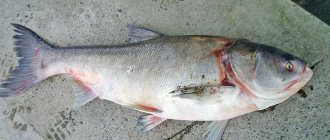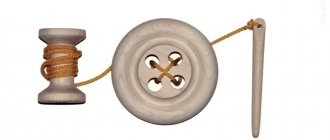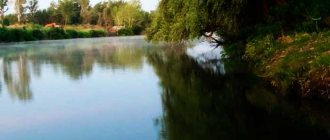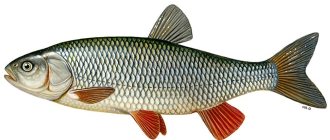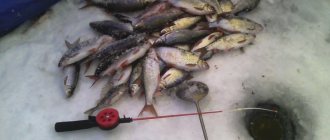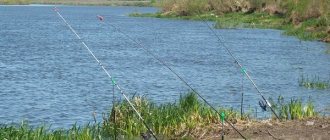Where are silver carp found?
Silver carp is a fish belonging to the carp family. It lives in freshwater bodies mainly in flocks.
Appearance of silver carp
This fish is found in rivers, lakes and ponds. Silver carp is very thermophilic and prefers well-warmed areas of reservoirs with standing water. The best time of year for fishing is the summer months and early autumn. It is found at the average depth of the reservoir and feeds mainly on phytoplankton.
Best biting time for silver carp
Silver carp can be caught at almost any time of the year, since it does not hibernate for the winter, but the warm season is more suitable. In cooler months, this fish can be caught, only as many professional fishermen note, it is much smaller in size due to the lack of food under water (insects and crustacean-like species).
As for the weather conditions for catching silver carp, the ideal option would be complete calm with a slightly drizzling warm rain. Under such conditions, rain gives the angler camouflage when fishing, and the fish does not see it, which is very important when fishing for silver carp. Such a fish is quite cunning and can swim up to the bait, dispersing all nearby fish, but it itself will not be caught or will swim away altogether.
Types of silver carp
The common, or white, taxon is the base taxon in the genus and has the largest intraspecific population. Also widely known is the southern (spotted, motley) silver carp (Hypophthalmichthys nobilis), which is native to China. It feels especially good in natural reservoirs and specialized farms in the Songhua River basin, from where it was accidentally introduced into the Amur as a result of severe floods in the 1950s.
In the new location, the taxon successfully acclimatized, spreading both to the upper and lower reaches of the river and to the Amur Estuary with a water salinity of 9-10 ppm. This circumstance became the main reason for the emergence of doubts - sea or river fish is silver carp.
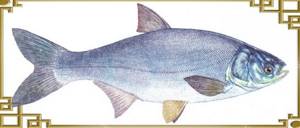
Silver carp
In fact, this is a freshwater representative of the ichthyofauna, capable of making feeding migrations to the slightly salty and well-warmed sea shelf with depths of 3-10 meters.
The white and motley species coexist peacefully in the same body of water and can form an independent hybrid form, which retains the acquired traits of the “purebred” parents over generations. In addition, the new taxon has improved morphology and climate resistance, which makes it a promising object for pond cultivation in the former Soviet republics, Russia and throughout Europe.
Bighead carp
It is distinguished by accelerated growth, shortened intestines, a huge head (up to 50% of body weight) and a shorter body with an olive back. The main heterogeneous color is characterized by scatterings of dark small spots throughout the body. Immature young animals have golden-colored sides, which become silver-gray with age. The eyes are located below the level of the mouth line and have a wider set. The keel on the light belly is less pronounced; it is clearly visible only between the ventral and anal fins.
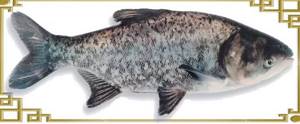
Bighead carp
Hybrid silver carp
Adapted to living in cool water. It has reduced head parameters (15-20% of the total dimensions), silver color, characteristic of the white species. At the same time, it grows quickly, which is typical for a variegated taxon. An important individual characteristic of a hybrid is high quality meat, peaceful disposition, calm behavior, and resistance to stress.
To learn more:
Ruff: spiny perch fish
Thanks to these morphological factors, the fish is compatible with all representatives of the ichthyofauna and is capable of steadily gaining weight even in the unfavorable microclimate of the reservoir. Among the hybrids, albinos with a golden-honey color are often found. The largest amount of yellow-orange pigment is found on the forehead, back, and fins.
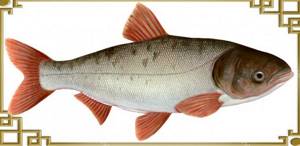
Hybrid silver carp
Fishing place
In the autumn, when thickets of algae do not produce fresh shoots, silver carp moves from shallow areas to thickets, closer to the pits. A good guide for catching fish is roach. It is by the presence of roach in the reservoir that you can find out exactly where to catch silver carp.
The best option for catching fish are reservoirs in which fish have been found for at least 10 years. It is also worth considering that if there are large thickets of fresh food around, it will be more difficult to catch silver carp with a fishing rod.
The presence of a large amount of live food can be assessed visually by the color of the water. There shouldn't be a lot of greenery in it.
Nutrition and lifestyle
Silver carp, like all its other species, is a pronounced schooling fish with a clear age hierarchy. Avoids strong currents and hard bottoms. It adheres to moderate depths with an abundance of vegetation. Tolerates a significant temperature range from 0 to +40°C. In winter, it goes to the pits, where it lies “hibernating” next to carp and crucian carp. Copes well with low oxygen levels in water.
Silver carp is a herbivorous fish, often jokingly called “underwater reclamation fish” or “water goat”. Food preferences depend not only on age, but also on species (see table).
| Age/species | Main food | Secondary feed |
| Whitebait of all types | zooplankton | zoobenthos |
| Young animals | zooplankton | phytoplankton |
| White | phytoplankton | zooplankton, aquatic plants, detritus |
| Motley | zooplankton and zoobenthos | phytoplankton |
| Hybrid | feed mixtures, phyto-, zooplankton | detritus, aquatic plants, zoobenthos |
Fry and fingerlings require a lot of nutrients for rapid growth, so they prefer the smallest aquatic animals and crustaceans (zooplankton), which contain huge amounts of protein. The same menu is typical for adult bigheaded carp.
As the standard species matures, it undergoes significant physical changes associated with the fusion of gill rakers into an effective filtering apparatus. This is why the fish switches to feeding on phytoplankton (single-celled algae).
Due to this feature, silver carp is widely used in aquaculture to prevent or eliminate the consequences of the rapid proliferation of blue-green algae (water blooms).
The hybrid species is a universal eater and easily adapts to special feed mixtures that provide intensive weight gain.
To learn more:
Ide: description of fish, habitat and lifestyle
Rod and fishing rod equipment
Silver carp are mainly a diurnal fish and bite from early morning until noon. Based on these characteristics, it is worth selecting the appropriate equipment for the fish.
Read more about the correct equipment of a float fishing rod in a special article.
The general diagram of the equipment of any float fishing rod in the figure:

Please note in the left picture below the sinker pellets there is a carabiner that connects the main fishing line with a leash, which is thinner in diameter and serves to camouflage the fishing line so as not to spook the fish with the equipment. You can find out how to tie a leash to the main line here.
Attention! It is very important that the float is loaded correctly. The entire body of the float should be recessed under the water, and only the plastic/wooden tip should be visible above the water. If the barrel is visible above the surface, then add weights to the line.
About how to make float equipment for silver carp. Helpful tips:
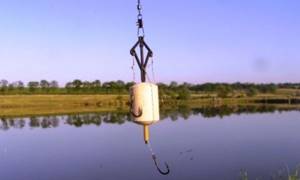
technoplankton has proven itself well - an attractive bait for carp fish species. This is a specially created product for this type of fish. It is a small barrel with a recess for fastening. For silver carp, it is light blue in color.
The video describes this type of silver carp fishing:
Features of summer fishing
Summer begins with silver carp leaving for spawning, which ends by July. It spawns in places where the water flow is most active. Spawning most often occurs after several strong warm rains in a row. Silver carp no longer bites on artificial baits. The silver carp shows the greatest interest in plant baits and insects.
It is best to fish in the morning when they are most active. Activity also increases as the water temperature increases. The larger it is, the greater the silver carp’s appetite. The best bite will be when the water is clear and clean. With the beginning of flowering in the reservoir, the bite will practically disappear.
Fishing for silver carp in the summer is carried out near the edges, overgrown with plants, near the coastal shallows, which are well warmed up by the sun. What is the best equipment for summer silver carp fishing? Of course, this is a spinning rod and a float rod. The usual fishing depth is 2 or 3 meters. But in bad weather, look for silver carp in snags and drifts, as well as at great depths.
Bait for silver carp
Silver carp, like all carp fish, loves:
- fragrant black bread crumb;
- peas;
- anise.
Many anglers catch large silver carp using bread balls or pea porridge. Both ready-made purchased mixtures for silver carp or carp fish, as well as home-prepared ones, can serve as bait. When preparing bait, it should be taken into account that fish react mainly to the smell and color of the bait. It would be useful to add:
- vegetable oil;
- anise;
- a little red food coloring (to add color);
- bread crumb;
This will help the fish notice the bait faster and swim to the place where it was caught.
Attachments and baits for silver carp
When fishing and choosing a bait for a hook, you need to be guided by the fact that the sizes of the mouth, bait and hook must match each other. A small fish will not sit on a large hook, and will not swallow large bait at all.
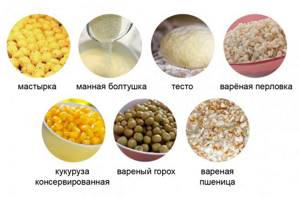
When catching silver carp on a float, you should choose a standard carp rod for long-distance casting. The main difference will be the preparation of bait, floats and baits.
Weights should be calculated at a depth of 10-15 cm.
Features of autumn fishing
Since the thickhead fish is very thermophilic, the approaching cold weather does not please it at all. By mid-autumn, underwater vegetation disappears. To feed, silver carp have to go deep from the shore, deeper to the bottom. Feeding ends when the water temperature drops to 8 degrees Celsius. At this time, the silver carp goes into the wintering hole.
To catch this fish in the fall, it is important to take into account the weather. The chances of catching it are higher when it is relatively warm outside, it is drizzling and there is no wind. To find the location of the silver carp, watch the roach: they are easier to find and often coexist with the silver carp. Together with the roach, it eats the remains of plant food. Watch the video that will help you understand the secrets of autumn fishing.
The fish is very suspicious. Therefore, the fisherman must camouflage himself and ensure complete silence. If it is noisy, the silver carp will quickly leave. When a silver carp detects extraneous sounds, it will begin to jump like an acrobat, but the bait will not interest it.
The best time for catching silver carp is late autumn. At this time, each individual has already made good reserves for the winter. In addition, in the fall they filter the water to collect leftover food. At the same time, the fish may swallow the hook if you throw the tackle nearby.
